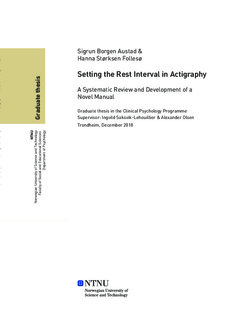| dc.description.abstract | Sleep is becoming an increasingly important topic in the study of mental and physical health. Several methods exist for measuring sleep duration and quality. Actigraphy has become one of the most applied methods due to its easy administration and non-invasive nature. A persistent problem with actigraphy is its struggle to distinguish inactive behaviour from time spent resting and attempting to sleep. This issue is apparent when the algorithm attempts to identify the rest interval. The rest interval onset and offset, however, can be changed manually. This thesis consists of two studies, both considering actigraphic data processing and practices for setting rest intervals.
In Study 1, through a systematic literature review, we sought to identify common practices for processing actigraphic data and investigate whether standardized guidelines for setting the rest interval exist. We reviewed an extensive selection of research articles (N = 1,061). The results indicate that methods and reporting practices are inconsistent and that there is a need for an established standardized procedure for setting the rest interval. Therefore, we developed a stepwise and easily applied manual. It combines subjective sleep measures with objective actigraphic measures to either validate or change algorithmically defined rest intervals. Our manual includes a screening process that automatically identifies valid rest intervals. This process distinguishes our manual from existing procedures.
In Study 2, we aimed to empirically test the manual for defining rest intervals developed in Study 1. The manual was applied to a dataset of 537 nights from the sleep study SLEEPIC. Participants (N = 55) were aged 19-33 (M = 22.69, SD = 3.024). The screening process successfully identified 37.1% valid rest interval onsets and 63.9% valid rest interval offsets. Three scorers independently applied the manual to the screened dataset, and agreement between scorers was high both in rest onsets (a = .975) and offsets (a = .998). Applying the manual to the dataset resulted in a shortening of the rest interval by 36 minutes and 19 seconds on average. There were significant changes (p < .001) in all sleep estimate outcomes after applying the manual. Based on the results, we conclude that the proposed manual saves scorers time by screening out a large proportion of the rest intervals. It is applicable with high agreement between scorers, produces significant changes to sleep variables, and it reduces noise in actigraphic datasets. Thus, the manual is a promising candidate for common practice. | nb_NO |
